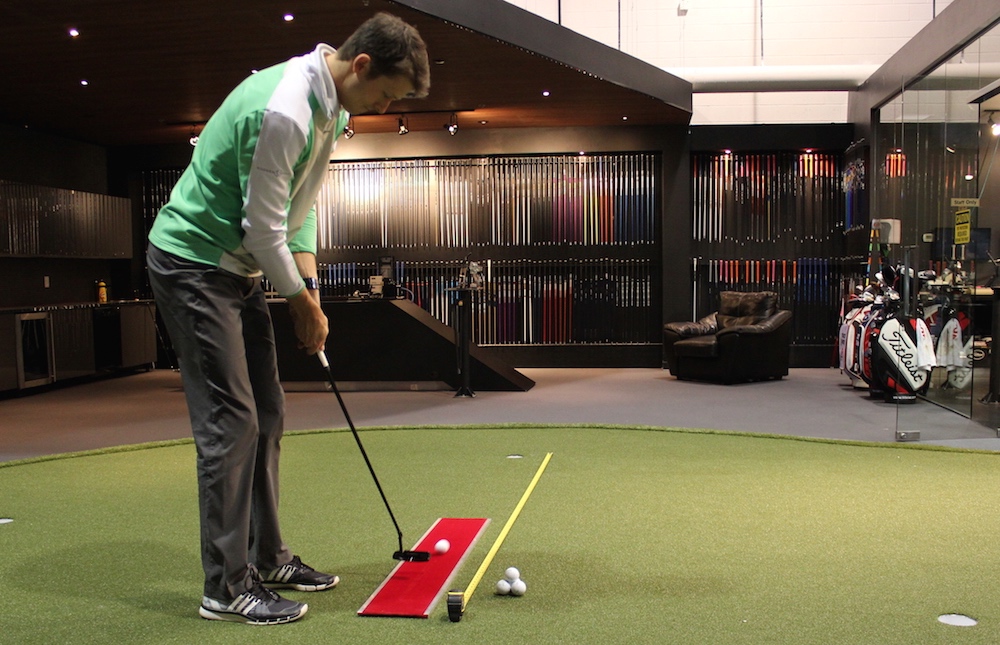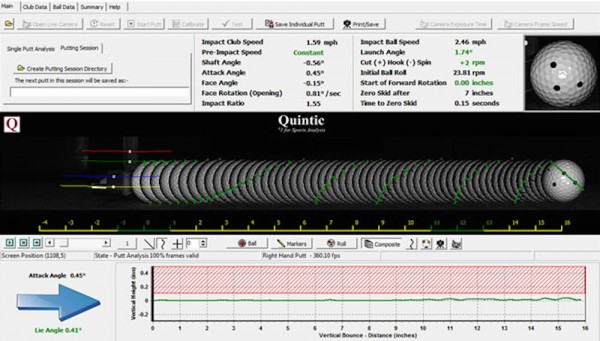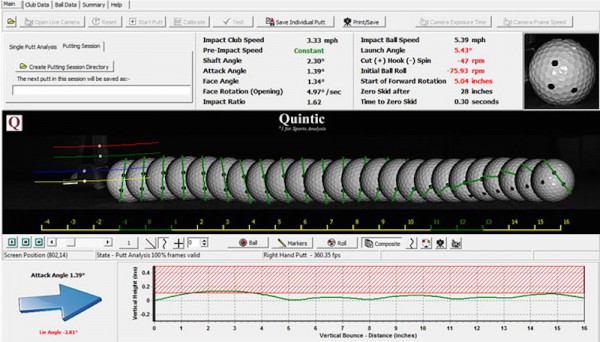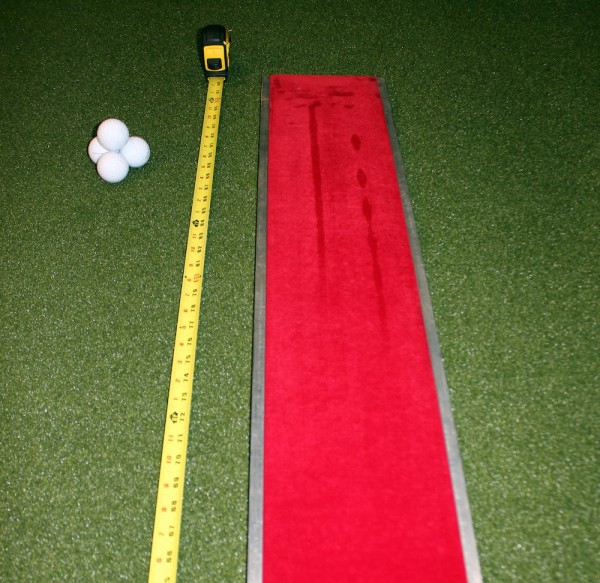Opinion & Analysis
The key to putter fitting? Know your roll

This is the second installment of a four-part series from Modern Golf on putter fitting and the Quintic System.
Find a busy practice putting green, and it’s almost guaranteed that you’ll see at least a few golfers obsessing over the motion of their putting stroke. They’re usually the ones who are using some kind of training aid to help them groove their stroke in a certain way.
For many golfer, it can be time well spent. But what they might not know is that the way their putter moves is only half the equation to good putting. Did you know that two putts with the same clubhead speed can travel significantly different distances? Did you also know that most golfers actually do a good job of consistently swinging the putter through at their desired speed? So why do so many golfers have problems with their distance control? The other half of the equation is controlling what is called their ball roll.
How do golfers control how their ball roll? How should the ball be rolling? It is a very difficult question to answer without using high-speed cameras and motion capturing. Using a system called Quintic, we provide golfers the knowledge and data they need to putt their best. Understanding this data will improve your game.
The image below shows what an ideal 8-foot putt looks like on our Quintic System.
Forward Rotation
As you can see, the ball instantly started to rotate forward off the putter face. A ball that has negative initial ball roll, or “backspin,” will lose speed and can deflect offline. Having the ball rotate forward off the face will give players better distance control with their putts because the ball will lose less energy and stay on its intended line longer. This will aid the ball in rolling over debris and other imperfections on the green such as ball marks, spike marks, etc.
Having anywhere from +25 rpm to +50 rpm initial ball roll is ideal. Any higher and the ball will roll out longer because it will be carrying more momentum. This can make downhill 5 footers scarier than they already are. With an rpm under +20 rpm, the ball doesn’t carry as much momentum to the hole.
Launch
The ball was launched at about 1.75 degrees. An ideal launch angle on most greens is between 0.75 degrees and 2 degrees. Much like a driver, controlling launch has a big influence on how far the ball will travel. That is because on the green, a ball will sit in a small depression as a result of gravity. The ball needs to be launched out of this depression — and not too high or too low. Optimal launch should change depending on the blade length of the grass and the type of putting surface. On lush greens with a longer blade length, the ball will sit in a deeper depression. On firm greens with a short blade length, the ball will not sit in such a deep depression, and for that reason not as much launch is required.
The image below shows what happens to a putt that has a launch angle that is too high.
Zero Skid
Minimal skid is ideal. On a well struck putt, there should be less than 10 percent skid for the total distance the ball travels. So on an 8-foot putt, ideally there should be less than 10 inches of skid (see first image). Once “zero skid” occurs, the ball starts rolling on top of the grass smoothly. When there is too much skid, the result is a loss of distance and ball speed. Every time the ball bounces and strikes the putting surface it loses energy — energy that has been factored into your putt for speed and distance. These putts tend to come up short and offline, and this often happens with long putts or lag putts.
Below are images of a “dew board.” The board simulates putting through an early morning dew where it is easy to see launch and skid. There are two visible lines on the board. The putt that has a flat and consistent line has optimal launch and minimal skid. The putt that looks dotted or chattered has launched too high, increasing the zero skid parameter. The dots are where the ball has struck the putting surface and continues to hop until it reaches zero skid.
Every putt, at some point, reaches zero skid. Reducing the amount of time it takes for the ball to reach zero skid will ensure that the ball will lose minimal energy and carry more momentum to the hole.
Impact Ratio
This refers to how efficiently clubhead speed is converted into ball speed. For all of those Trackman users out there, this is the same as smash factor. It is a simple calculation: ball speed divided by clubhead speed. Controlling the speed that the ball comes off the face is crucial. This is achieved when the center mass of the club head makes contact with the center mass of the golf ball. Any off-center strike results in a loss of ball speed and face deflection, causing the ball to roll offline with less speed.
We’ve all hit full shots that weren’t solidly struck and they come up short of our target. The exact same thing happens when we don’t hit a putt solid, but it’s much harder to feel the mishit because the clubhead speed is much slower through impact with a putter. This is where most golfers struggle.
The face of the putter also needs to be square to the path of the club. Otherwise, you’ll see a glancing blow that also reduces ball speed. The type of putter a player uses also has an effect on ball speed. Putters with softer inserts reduce ball speed because of reduced energy transfer from the club head to the ball. To illustrate where you strike the ball on the clubface, spray the face of the putter with Doctor Scholl’s foot spray. It will show you where the ball is making contact with the face, and has minimal effect on ball speed and friction.
Certainly there are other parameters to consider, but this article should provide golfers with a general concept that they may not have considered in the past. Without knowing what the ball is doing, it is very difficult to teach someone proper putting mechanics. Players who have a better understanding of how the ball is rolling have a better chance of improving their game on the greens. Therefore, go get fit for a putter and KNOW YOUR ROLL.
Call or email to book your appointment today at Modern Golf.
Related
- Part 1: Why everyone can benefit from Quintic
- Part 2: The key to putter fitting? Know your roll
- Part 3: Face the facts in putting — Controlling face angle
- LIKE100
- LEGIT37
- WOW17
- LOL0
- IDHT0
- FLOP2
- OB1
- SHANK10
19th Hole
Vincenzi’s 2024 Zurich Classic of New Orleans betting preview

The PGA TOUR heads to New Orleans to play the 2023 Zurich Classic of New Orleans. In a welcome change from the usual stroke play, the Zurich Classic is a team event. On Thursday and Saturday, the teams play best ball, and on Friday and Sunday the teams play alternate shot.
TPC Louisiana is a par 72 that measures 7,425 yards. The course features some short par 4s and plenty of water and bunkers, which makes for a lot of exciting risk/reward scenarios for competitors. Pete Dye designed the course in 2004 specifically for the Zurich Classic, although the event didn’t make its debut until 2007 because of Hurricane Katrina.
Coming off of the Masters and a signature event in consecutive weeks, the field this week is a step down, and understandably so. Many of the world’s top players will be using this time to rest after a busy stretch.
However, there are some interesting teams this season with some stars making surprise appearances in the team event. Some notable teams include Patrick Cantlay and Xander Schauffele, Rory McIlroy and Shane Lowry, Collin Morikawa and Kurt Kitayama, Will Zalatoris and Sahith Theegala as well as a few Canadian teams, Nick Taylor and Adam Hadwin and Taylor Pendrith and Corey Conners.
Past Winners at TPC Louisiana
- 2023: Riley/Hardy (-30)
- 2022: Cantlay/Schauffele (-29)
- 2021: Leishman/Smith (-20)
- 2019: Palmer/Rahm (-26)
- 2018: Horschel/Piercy (-22)
- 2017: Blixt/Smith (-27)
2024 Zurich Classic of New Orleans Picks
Tom Hoge/Maverick McNealy +2500 (DraftKings)
Tom Hoge is coming off of a solid T18 finish at the RBC Heritage and finished T13 at last year’s Zurich Classic alongside Harris English.
This season, Hoge is having one of his best years on Tour in terms of Strokes Gained: Approach. In his last 24 rounds, the only player to top him on the category is Scottie Scheffler. Hoge has been solid on Pete Dye designs, ranking 28th in the field over his past 36 rounds.
McNealy is also having a solid season. He’s finished T6 at the Waste Management Phoenix Open and T9 at the PLAYERS Championship. He recently started working with world renowned swing coach, Butch Harmon, and its seemingly paid dividends in 2024.
Keith Mitchell/Joel Dahmen +4000 (DraftKings)
Keith Mitchell is having a fantastic season, finishing in the top-20 of five of his past seven starts on Tour. Most recently, Mitchell finished T14 at the Valero Texas Open and gained a whopping 6.0 strokes off the tee. He finished 6th at last year’s Zurich Classic.
Joel Dahmen is having a resurgent year and has been dialed in with his irons. He also has a T11 finish at the PLAYERS Championship at TPC Sawgrass which is another Pete Dye track. With Mitchell’s length and Dahmen’s ability to put it close with his short irons, the Mitchell/Dahmen combination will be dangerous this week.
Taylor Moore/Matt NeSmith +6500 (DraftKings)
Taylor Moore has quickly developed into one of the more consistent players on Tour. He’s finished in the top-20 in three of his past four starts, including a very impressive showing at The Masters, finishing T20. He’s also finished T4 at this event in consecutive seasons alongside Matt NeSmith.
NeSmith isn’t having a great 2024, but has seemed to elevate his game in this format. He finished T26 at Pete Dye’s TPC Sawgrass, which gives the 30-year-old something to build off of. NeSmith is also a great putter on Bermudagrass, which could help elevate Moore’s ball striking prowess.
- LIKE7
- LEGIT3
- WOW1
- LOL1
- IDHT0
- FLOP3
- OB1
- SHANK1
19th Hole
Vincenzi’s 2024 LIV Adelaide betting preview: Cam Smith ready for big week down under

After having four of the top twelve players on the leaderboard at The Masters, LIV Golf is set for their fifth event of the season: LIV Adelaide.
For both LIV fans and golf fans in Australia, LIV Adelaide is one of the most anticipated events of the year. With 35,000 people expected to attend each day of the tournament, the Grange Golf Club will be crawling with fans who are passionate about the sport of golf. The 12th hole, better known as “the watering hole”, is sure to have the rowdiest of the fans cheering after a long day of drinking some Leishman Lager.
The Grange Golf Club is a par-72 that measures 6,946 yards. The course features minimal resistance, as golfers went extremely low last season. In 2023, Talor Gooch shot consecutive rounds of 62 on Thursday and Friday, giving himself a gigantic cushion heading into championship Sunday. Things got tight for a while, but in the end, the Oklahoma State product was able to hold off The Crushers’ Anirban Lahiri for a three-shot victory.
The Four Aces won the team competition with the Range Goats finishing second.
*All Images Courtesy of LIV Golf*
Past Winners at LIV Adelaide
- 2023: Talor Gooch (-19)
Stat Leaders Through LIV Miami
Green in Regulation
- Richard Bland
- Jon Rahm
- Paul Casey
Fairways Hit
- Abraham Ancer
- Graeme McDowell
- Henrik Stenson
Driving Distance
- Bryson DeChambeau
- Joaquin Niemann
- Dean Burmester
Putting
- Cameron Smith
- Louis Oosthuizen
- Matt Jones
2024 LIV Adelaide Picks
Cameron Smith +1400 (DraftKings)
When I pulled up the odds for LIV Adelaide, I was more than a little surprised to see multiple golfers listed ahead of Cameron Smith on the betting board. A few starts ago, Cam finished runner-up at LIV Hong Kong, which is a golf course that absolutely suits his eye. Augusta National in another course that Smith could roll out of bed and finish in the top-ten at, and he did so two weeks ago at The Masters, finishing T6.
At Augusta, he gained strokes on the field on approach, off the tee (slightly), and of course, around the green and putting. Smith able to get in the mix at a major championship despite coming into the week feeling under the weather tells me that his game is once again rounding into form.
The Grange Golf Club is another course that undoubtedly suits the Australian. Smith is obviously incredibly comfortable playing in front of the Aussie faithful and has won three Australian PGA Championship’s. The course is very short and will allow Smith to play conservative off the tee, mitigating his most glaring weakness. With birdies available all over the golf course, there’s a chance the event turns into a putting contest, and there’s no one on the planet I’d rather have in one of those than Cam Smith.

Louis Oosthuizen +2200 (DraftKings)
Louis Oosthuizen has simply been one of the best players on LIV in the 2024 seas0n. The South African has finished in the top-10 on the LIV leaderboard in three of his five starts, with his best coming in Jeddah, where he finished T2. Perhaps more impressively, Oosthuizen finished T7 at LIV Miami, which took place at Doral’s “Blue Monster”, an absolutely massive golf course. Given that Louis is on the shorter side in terms of distance off the tee, his ability to play well in Miami shows how dialed he is with the irons this season.
In addition to the LIV finishes, Oosthuizen won back-to-back starts on the DP World Tour in December at the Alfred Dunhill Championship and the Mauritus Open. He also finished runner-up at the end of February in the International Series Oman. The 41-year-old has been one of the most consistent performers of 2024, regardless of tour.
For the season, Louis ranks 4th on LIV in birdies made, T9 in fairways hit and first in putting. He ranks 32nd in driving distance, but that won’t be an issue at this short course. Last season, he finished T11 at the event, but was in decent position going into the final round but fell back after shooting 70 while the rest of the field went low. This season, Oosthuizen comes into the event in peak form, and the course should be a perfect fit for his smooth swing and hot putter this week.

- LIKE12
- LEGIT3
- WOW1
- LOL1
- IDHT0
- FLOP1
- OB1
- SHANK1
Opinion & Analysis
The Wedge Guy: What really makes a wedge work? Part 1

Of all the clubs in our bags, wedges are almost always the simplest in construction and, therefore, the easiest to analyze what might make one work differently from another if you know what to look for.
Wedges are a lot less mysterious than drivers, of course, as the major brands are working with a lot of “pixie dust” inside these modern marvels. That’s carrying over more to irons now, with so many new models featuring internal multi-material technologies, and almost all of them having a “badge” or insert in the back to allow more complex graphics while hiding the actual distribution of mass.
But when it comes to wedges, most on the market today are still single pieces of molded steel, either cast or forged into that shape. So, if you look closely at where the mass is distributed, it’s pretty clear how that wedge is going to perform.
To start, because of their wider soles, the majority of the mass of almost any wedge is along the bottom third of the clubhead. So, the best wedge shots are always those hit between the 2nd and 5th grooves so that more mass is directly behind that impact. Elite tour professionals practice incessantly to learn to do that consistently, wearing out a spot about the size of a penny right there. If impact moves higher than that, the face is dramatically thinner, so smash factor is compromised significantly, which reduces the overall distance the ball will fly.
Every one of us, tour players included, knows that maddening shot that we feel a bit high on the face and it doesn’t go anywhere, it’s not your fault.
If your wedges show a wear pattern the size of a silver dollar, and centered above the 3rd or 4th groove, you are not getting anywhere near the same performance from shot to shot. Robot testing proves impact even two to three grooves higher in the face can cause distance loss of up to 35 to 55 feet with modern ‘tour design’ wedges.
In addition, as impact moves above the center of mass, the golf club principle of gear effect causes the ball to fly higher with less spin. Think of modern drivers for a minute. The “holy grail” of driving is high launch and low spin, and the driver engineers are pulling out all stops to get the mass as low in the clubhead as possible to optimize this combination.
Where is all the mass in your wedges? Low. So, disregarding the higher lofts, wedges “want” to launch the ball high with low spin – exactly the opposite of what good wedge play requires penetrating ball flight with high spin.
While almost all major brand wedges have begun putting a tiny bit more thickness in the top portion of the clubhead, conventional and modern ‘tour design’ wedges perform pretty much like they always have. Elite players learn to hit those crisp, spinny penetrating wedge shots by spending lots of practice time learning to consistently make contact low in the face.
So, what about grooves and face texture?
Grooves on any club can only do so much, and no one has any material advantage here. The USGA tightly defines what we manufacturers can do with grooves and face texture, and modern manufacturing techniques allow all of us to push those limits ever closer. And we all do. End of story.
Then there’s the topic of bounce and grinds, the most complex and confusing part of the wedge formula. Many top brands offer a complex array of sole configurations, all of them admittedly specialized to a particular kind of lie or turf conditions, and/or a particular divot pattern.
But if you don’t play the same turf all the time, and make the same size divot on every swing, how would you ever figure this out?
The only way is to take any wedge you are considering and play it a few rounds, hitting all the shots you face and observing the results. There’s simply no other way.
So, hopefully this will inspire a lively conversation in our comments section, and I’ll chime in to answer any questions you might have.
And next week, I’ll dive into the rest of the wedge formula. Yes, shafts, grips and specifications are essential, too.
- LIKE32
- LEGIT7
- WOW1
- LOL1
- IDHT2
- FLOP3
- OB1
- SHANK3
-

 19th Hole2 weeks ago
19th Hole2 weeks agoDave Portnoy places monstrous outright bet for the 2024 Masters
-

 19th Hole2 weeks ago
19th Hole2 weeks agoTiger Woods arrives at 2024 Masters equipped with a putter that may surprise you
-

 19th Hole2 days ago
19th Hole2 days agoJustin Thomas on the equipment choice of Scottie Scheffler that he thinks is ‘weird’
-

 19th Hole2 days ago
19th Hole2 days ago‘Absolutely crazy’ – Major champ lays into Patrick Cantlay over his decision on final hole of RBC Heritage
-

 19th Hole3 weeks ago
19th Hole3 weeks agoReport: Tiger Woods has ‘eliminated sex’ in preparation for the 2024 Masters
-

 19th Hole1 week ago
19th Hole1 week agoTwo star names reportedly blanked Jon Rahm all week at the Masters
-

 19th Hole1 week ago
19th Hole1 week agoReport: LIV Golf identifies latest star name they hope to sign to breakaway tour
-

 19th Hole1 week ago
19th Hole1 week agoNeal Shipley presser ends in awkward fashion after reporter claims Tiger handed him note on 8th fairway


























Scooter McGavin
Feb 27, 2015 at 11:20 am
There is some good info on this article. I also agree that people can tend to overlook putter roll. I’d be curious for a little more info that goes into greater depth about its role in the fitting process with respect to different models’ grooves, inserts, centers of gravity, etc. and how it would directly affect one’s putter choice. Cheers!